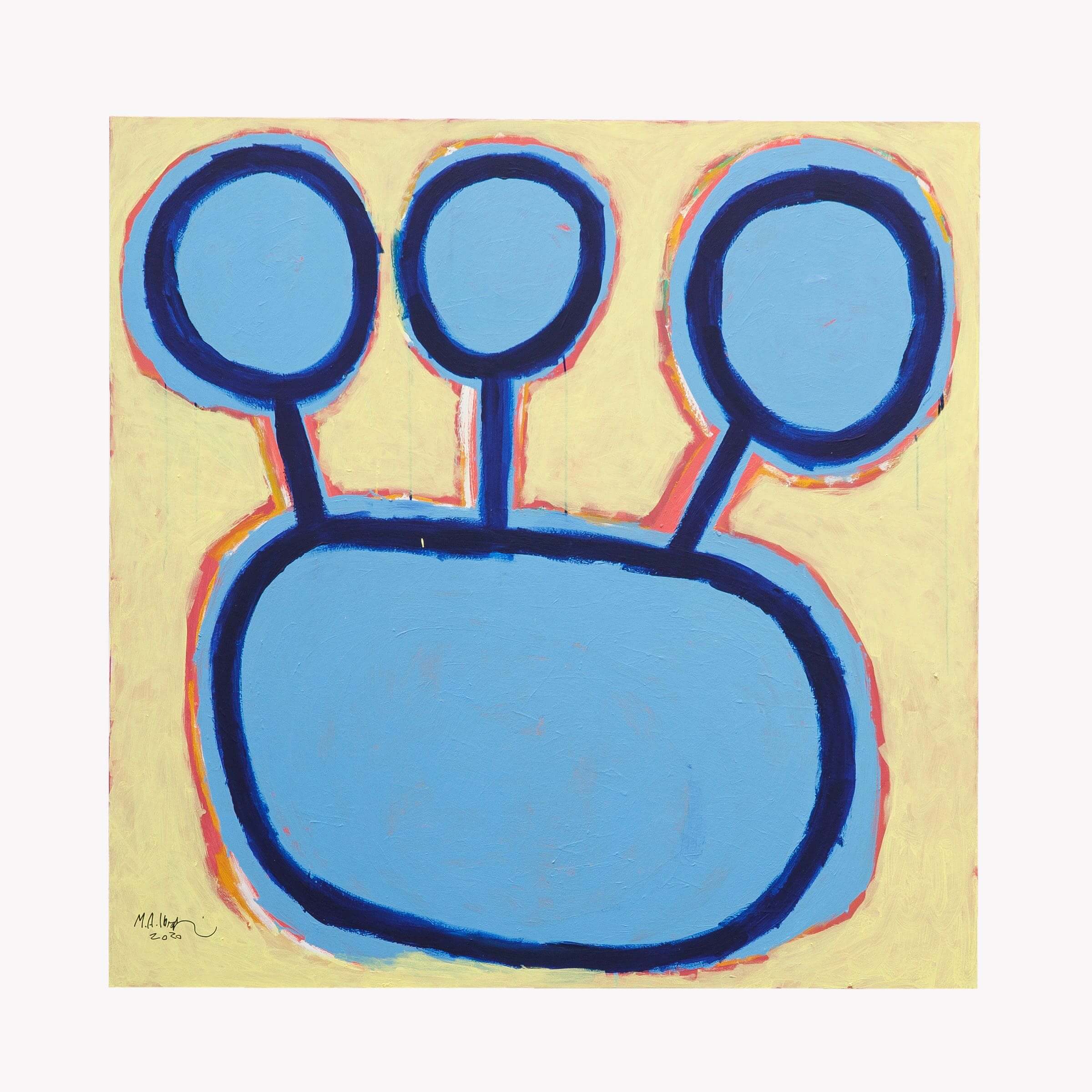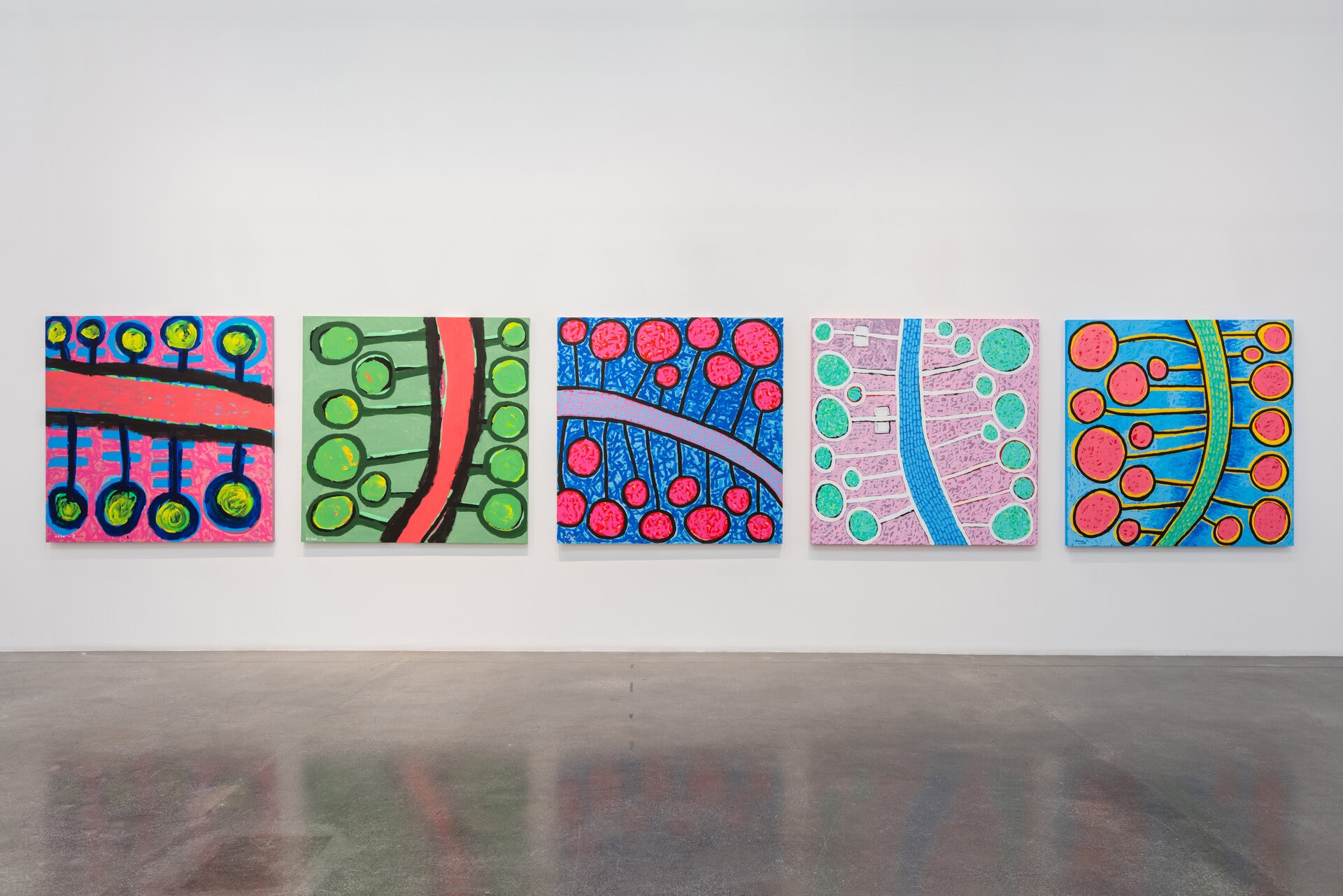What is between the eyelid and the eye: Mohamed Ahmed Ibrahim and Maya Allison in conversation
Mohamed Ahmed Ibrahim
In your work you go back and forth between neutral tones, natural colours and textures, and then very bright colours, both in your sculpture and in your paintings. In the lines series you use black and white lines, something you’ve been doing since at least the 1990s. They tell a story of markings on a page, counting time, maybe a reference to text, to windows, to structures, to buildings. More recently you began making paintings of these lines and then you started adding colour. They are much more figurative and yet clearly derived from the lines that you were doing before. There’s a series of paintings that are very large and you’ve called them the Boulevard series – in these I see a line curving down the centre and branches that come out into circles, it feels like we could be looking at an aerial view of a city from the airplane. I see a formal connection between these – they don’t look like buildings, they look like they could be plants or flowers, or a city seen from above. Do you think of them as the same body of work?
Yes, they are the same, which is why sometimes the names of the work can be confusing for the viewer. For me the names of my artworks are not important, they often come later. I like the shapes in all my works to be related to nature – to look like flowers, trees, blooms. I found the shapes for the boulevard in streets, of lines, or maybe a river and trees running alongside. I work in the same rhythm with symbols, or with a boulevard, or with flowers – some of the works I call a flower, they are real because they really are flowers – so in this case we go back again to the names. I have to give them a name because I saw it as a boulevard, so I want the viewer to see it as a boulevard, but he has a right to see it in in his own way.
Can you talk about the process of making a painting or a drawing and then your process for making a sculpture. How do you come up with the idea? How do you find the form?
It’s the same process. When I am working on objects I prepare my material first, which takes me time. I play with my own material, I sometimes mix it with coffee, sometimes with tea or tobacco, with grass or leaves. I need time to play – sometimes for 10 minutes, or one month – just to see how it has become dark, how it has changed. After this I can make the objects. When I start to do structures there is no plan, using cardboard or a box, I start with a dry object and add material onto this structure. Then the dry structure will become wet, like papier-mâché, then it starts moving, and I feel there is life coming to this dry structure, and it starts to make its own shape. I do not interfere, sometimes I add more or take some parts away – until both of us are satisfied, me and the object.
The process itself is important to me – I am like a child using my drum memory, the first knowledge I had in my life. You know in childhood you start fresh, after three months psychologists say your start to learn, you cry because by crying you will get the food or milk from your mother. I start to bring this early knowledge back to my work during the process of making my objects or my painting.
You were going to talk about shifting to painting.
When I am painting, I follow a ritual, I just dip my brush in the colour, make a point on the canvas and start to do the shape. Acrylic is more controllable than oil paint. I stopped painting with oil in 2019, but recently I felt nostalgic for it, so I made a painting, like Boulevard, with oil paint, which I found quite aggressive. You cannot control it – you need a long time, for example if you add one colour you have to wait for three or four days or sometimes two weeks for it to dry and then you can work again.

Do you feel that the work you do with oil is similar to the objects because they both require a long drying time and layering, that the acrylic doesn’t require?
Yes, with oil, because it’s thick, you can find depth, not like acrylic when you need to add a paste or something else. So now I found what I am doing in oil colour is the same as what I am doing with objects – I am not painting, I am making painting.

You’re making a painting instead of painting a painting – it’s like you are building a painting– it’s a very interesting distinction. There was a long period in the 1980s and 1990s when your paintings had quite a bit of colour – you were still doing the black and white lines and the symbols but you also made paintings with organic flowers and colour and then between 2000-2010 you were working more with organic material, not so much bright colour. At the Kochi Biennial in 2016 you did a whole series of collages that worked with brown and beige and very neutral tones and then you switched to really bright colours and you also moved studios to a studio that you call the candy box. Could you tell me the story about your artwork and how you respond to where you are? What makes you change from neutral tones to bright?
I do not choose any material – it chooses me. When I am in a new area or culture like in Kochi and you talk in a different language, eat different the food – everything is changed. So yes, being in a new place means there is new material – the material that belongs to that place.
So material that you found naturally around Kochi and Kerala.
Yes, exactly –when I was in Kochi I used leaves from a different kind of tree, which gave me a brownish colour. The environment is there to guide me.
No, they are all related together. I am going beyond the abstract, for the shapes, I try to go back to the lines. I tried to do it, then I found even the point is not the minimum, there is a shape before the point, so the point is not the beginning, it’s not the start, there’s something behind it. So, from this I know: from my working experience that what I am looking for, is what’s before the point.
The way that you think about what’s before the point – it reminds me of what’s behind the eyelid – what is between the eyelid and the eye.
Yes – I am working on this and I am still between these things – there is a huge space between this. Even when we go back to the drum memory, it’s full of the knowledge we get from childhood, which is more important than knowledge we have later. Everyone forgets their knowledge from childhood but sometimes it comes to them automatically, but they are unaware of it: that is how they are different to me, because I am aware of it. I go deep into my drum memory to find it, to bring it back again. So yes, sometimes I see this in my objects, especially the latest ones that are colourful – these are toys made by a man who is 60 years old. He is making toys from his childhood memories. These are my toys, and I play with them.




